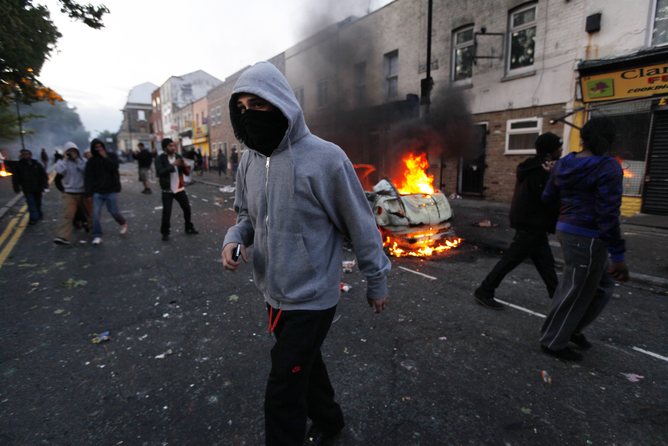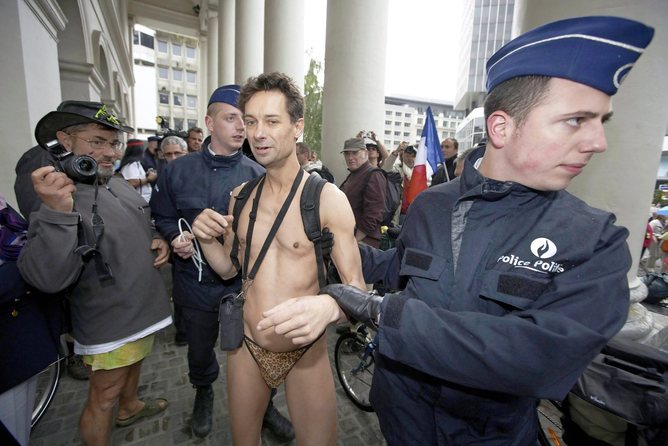For those of us who grew up with marches and rallies as the default type (or stereotype) of protest, some of the 21st-century forms – such as The World Naked Bike Ride or Nannas Knitting Against Gas and Greed – raise new questions. Are these new “peaceful” methods of protest replacing rallies and riots? What about e-activism? How are trends changing, and do any of these methods work better to change the world?
Let us first ask: why nude knitting?
Shocking and comforting, intimate and public, it was only a matter of time before the nude knitting protest undertaken by “performer craftivist” Casey Jenkins last year. But in fact nudity and protest have a long history.
Activists pursue two broad goals: to convert decision-makers, the public or third parties to their cause; and to confront political opponents, or the perceived sources of problems, and persuade them to stop doing something.
When more ideologically-compatible governments are in power, activists aim to convert decision-makers: they often use conventional methods to bring issues into the public eye so that favourably-minded governments have an excuse to act.
When more ideologically-opposed governments are in power, activists diverge towards two goals: to try to sway third parties and public opinion to exert influence on the recalcitrant authorities, and/ or to try to persuade opponents that the status quo has unacceptable costs.
In general, swaying public attention is hard: our research about the effectiveness of different kinds of protest suggests that the more conventional the protest format, the more people are open to the message, but the less motivated to attend to it. The less conventional the protest format, the more media and public attention, but also the more negative that public and media attention tends to be.
So how to have an unconventional yet attractive protest? If the public’s stereotype of protesters is angry young men in balaclavas throwing rocks, naked protest has a variety of advantages. It is unusual and therefore likely to attract coverage and public attention.

Some of it is sexy – and ostensibly sex sells. Naked people are seen as more sensitive to emotion and pain, and less in control. So if the nude protesters are arty and upbeat, it’s possible that punters will be more attentive to the message and more open to its merits. Or they might just ogle and objectify them – it’s possible both reactions will be observed.
One virtue is that naked protesting also could attract a different demographic from the small band of earnest mainstream activists: more fun, younger, exhibitionist – “a wide range of participants”, as the World Naked Bike Ride wikisite blandly notes.
Similarly, knitting could be associated with nurturing women, with elders – people you respect and want to listen to. Knitting protests can also attract and speak to a different demographic than placards and public marches.
It’s often the same people who participate in conventional and unconventional forms of protest. But commenting on the appeal of new, unconventional methods, Kim Stewart, a participant in the Knit Your Revolt Collective told us, while we were researching this article:
Creative approaches help alleviate the anxiety people are feeling without endangering them. I would also emphasise that the artistic and creative responses to problems we are seeing in Australia at the moment are both urges amongst activists to be creative (as opposed to critical - “down with” messages) and needing to capture the attention of a biased and sensation driven media.
[…] More conflictual types of protest are [sometimes also] reflections of patriarchal and hierarchical thinking used by the state, and result in protest spaces that many women will not feel safe in, with aggression being visible from both sides.
An end to rallies?
Despite the front-page photos, activism that makes the mainstream media and public attention only ever represents a small amount of the activism underway. The more unconventional the protest, the more likely the media coverage – so protests are especially likely to be noted if they feature sex and violence.
People tend to remember Vietnam-era protests as marches, but there was plenty of non-violence alongside, from sit-ins to folk songs by the likes of Peter Seeger.
Naked or knitting protests are also likely to stick in punters’ memories, compared to politically-savvy protesters who appear to be increasingly corporate and “on message”.
The latter may be nearly invisible to the general public and in media coverage, their audiences primarily being the decision-makers and their spin-doctors.
Protest constrained
Violent illegal political action is comparatively rare in the West.
Activists are facing a suite of measures by government designed to constrain the abilities of protesters to disrupt, from exclusion zones and move-on rules to criminalisation and e-surveillance.
The recent treatment of the female Russian rock group Pussy Riot and the Greenpeace Arctic 30 provides plenty of examples.
New laws set limits on freedom of speech and association.
We now see signs of a new wave of outlaw activists as the legitimacy of the state and the counter-police has been eroded by authorities’ retreat from the rule of law and judicial independence (from detention centres to Guantanamo Bay; from bikies to mandatory sentences).

Whistleblowers such as Bradley Manning and Edward Snowden have been motivated and able to have truly staggering impact, disclosing illegal and embarrassing behaviour by authorities by the terabyte. Digital frontiers allow hacktivists such as Anonymous to expose cronyism or parochialism, and to attack those who attack “net neutrality”.
The driving perception is that illegal confrontational actions are required now because authorities have limited the opportunity to protest legally, and ignore protests within the newly narrow legal channels.
Structural factors such as stagnation of real wages also play a part in cycles of social unrest, of course, and there are gender and age gaps in perception and action.
But our research (and that of others) has shown that when the system is seen as corrupt, people believe normal democratic protest will probably not work, and then “illegal” direct action appears as more legitimate.
As perceptions of corruption and the legitimacy of “illegal” action spread, the chances of radicalisation increase exponentially, because radicalisation is a group activity. Unsurprisingly, then, there is apparently an increasing readiness to engage in direct action among radical youth.
The downside of violent protest
Disruptive or violent protest has many obvious disadvantages: the chance of retaliation, peaceful or moderate actors discredited by others’ extremism, and a more reactionary, defensive state, justifying new repression on the grounds of “terrorist” activity.

In addition, some scholarly research, including our own, suggests that violence isn’t as effective as non-violent protest in communicating the illegitimacy of the situation. (See also Malcolm Gladwell’s discussion here.)
Perhaps this is why, after radicalism, many activists return to conventional protests. Or – as the state oscillates between more or less coercive periods – activists and activist groups also may swing in tandem between more or less confrontational strategies.
It seems clear that many people believe protest marches work to embarrass and even overthrow repressive, authoritarian regimes: they have put their bodies on the line around the world to say so, from Egypt to Brazil to Singapore to China, to name a few.
What about e-activism?
Alongside this wave of bodies on the march, a new world of e-activism has flourished in the last five years – as organisations such as Avaaz, GetUp, Moveon, and change.org have attracted millions of members and given voice to thousands of causes.
For activists seeking to convert a broader public, e-actions offer more opportunity to engage that public directly) – the more so because new social media allow speedy transmission of inspirational, funny or outrageous images that mobilise others.
A great deal of e-activism has effectively captured public attention by creating new media forums that supercede print newspapers and TV stations monopolised by political conservatives.

When an audience or constituency is dispersed geographically, they are much more easily reached and united online.
There is ongoing debate about e-tactics’ moral virtue and effectiveness.
Snarktivism – memes that make fun of e-activism – has arisen too. Still, we’ve found that e-activism complements offline activism and that the two forms can be effective and mutually reinforcing.
As with the sensational protests described above, glib e-campaigns may work best to attract the public’s attention to issues and to community groups, which can provide access to more in-depth information and more effortful and committed intervention opportunities.
Coming soon: nudity, violence, online knitting?
A sense of humour is vital to activists on many levels.
It sustains motivation in the face of chronic failure, and through long years of opponents’ political ascendency. It guards against the tendency to off-putting shrillness, and instils humility in the earnestly judgemental. It makes attractive a message which might otherwise be seen as too scary or confronting to process.
But the quirky and offbeat are irritating to many serious-minded activists – so nude protesting and knitting action may not surpass the fully-clothed protest march in popularity, in the near future. We also doubt violent protest will catch on in Australia without a substantial escalation of police and state corruption.
But new expressions of artistry, confidence and creativity in public action are likely to draw attention to worthy causes, and to attract new demographics to their social movements.
In that spirit, good luck to Melbourne’s upcoming World Naked Bike Ride, on March 30 – highlighting the country’s dependence on fossil fuel, its indecent exposure to carbon emissions, and the vulnerability of cyclists on the road.
Don’t forget your sunscreen!
